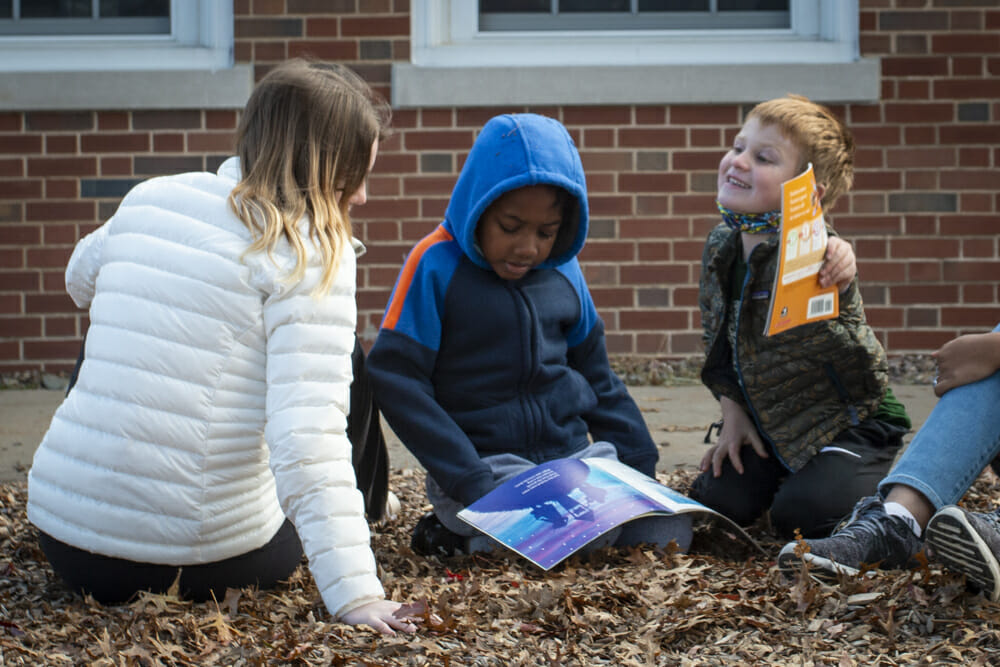Developing Lifelong Readers Through a Pandemic
 In the Spring of 2020, the lives of educators and librarians experienced great change alongside most (if not all) professions in our society. The then-new coronavirus pandemic certainly challenged our education systems in independent schools which have been so carefully developed over generations. As a member of the MICDS Lower School community, this meant using our much-anticipated spring break to pivot our education model into a virtual learning community for our youngest students. Pandemic pandemonium ensued and I wondered what this meant for the future, both immediate and long term, considering the work of librarians and the literacy practice of our students.
In the Spring of 2020, the lives of educators and librarians experienced great change alongside most (if not all) professions in our society. The then-new coronavirus pandemic certainly challenged our education systems in independent schools which have been so carefully developed over generations. As a member of the MICDS Lower School community, this meant using our much-anticipated spring break to pivot our education model into a virtual learning community for our youngest students. Pandemic pandemonium ensued and I wondered what this meant for the future, both immediate and long term, considering the work of librarians and the literacy practice of our students.
Addressing the immediate, our librarians were fortunate to « Zoom in’ » on virtual morning meetings, lead book talk discussions, and help students and parents to access a growing list of eBooks and digital resources from home. Though it was a little comforting to do all of this in the company of a labrador and bulldog, these weeks of virtual learning turned into months, and brought on anxiety as we all looked into the unknown of future school years. Addressing the long term, it’s clearly still a work in progress every day, as we collaborate to understand and define the look of education settings in a COVID-conscious world, including our libraries.
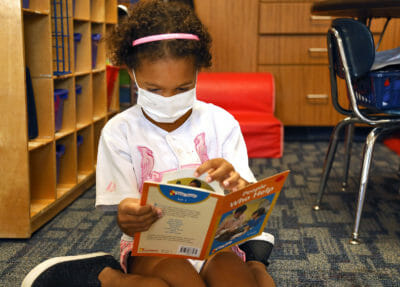 Though our routines, expectations, and practices as educators have been altered throughout the last two years, the roles and the objectives of MICDS educators and libraries, I believe, have not yielded an inch to the pandemic tide. As a librarian, this means continuing the work of developing lifelong readers and learners by fostering a love of reading for all students and challenging them to grow in literacy skills. The journey to uphold this service to our Lower School students has become uniquely challenging in practice, since the return of limited in-person learning at the start of last school year, and then return to whole classes this year. This unique challenge was offset with a unique reward though: in August of 2021, as we were finally able to share with our students, parents, and community: « The Library is back. »
Though our routines, expectations, and practices as educators have been altered throughout the last two years, the roles and the objectives of MICDS educators and libraries, I believe, have not yielded an inch to the pandemic tide. As a librarian, this means continuing the work of developing lifelong readers and learners by fostering a love of reading for all students and challenging them to grow in literacy skills. The journey to uphold this service to our Lower School students has become uniquely challenging in practice, since the return of limited in-person learning at the start of last school year, and then return to whole classes this year. This unique challenge was offset with a unique reward though: in August of 2021, as we were finally able to share with our students, parents, and community: « The Library is back. »
So, what does this mean?
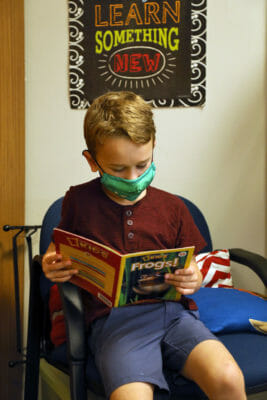 Perhaps the most exciting meaning behind this statement is the resumption of our extremely important work in developing lifelong readers. Many essential factors of this work may have been (or continue to be) restyled thanks to the pandemic and needs of our changing students, however, our core learning targets surrounding this mission have remained—and even improved—as we’ve reopened library doors this school year.
Perhaps the most exciting meaning behind this statement is the resumption of our extremely important work in developing lifelong readers. Many essential factors of this work may have been (or continue to be) restyled thanks to the pandemic and needs of our changing students, however, our core learning targets surrounding this mission have remained—and even improved—as we’ve reopened library doors this school year.
A central focus of the Lower School Library has always been to foster a love of reading within our students. Such joyful work it is to help our young learners become excited about reading, and we practice this every day. As educators, we at MICDS so often demonstrate a similar excitement to read and thus provide a positive example to follow. As librarians, we love to provide students with new materials every month catering to their ever-changing interests, and we are blessed with the means to provide such resources frequently. It’s humbling to watch students cheer and applaud to find out that they are coming to the library for a checkout day, and the library is often abuzz with productive energy as students browse the aisles to pick out new books for the week or work on academically supplemental activities in their library centers. It is our profound hope that this love for their library time carries on into the pages of their checked-out books.
Aside from delivering books into the hands of students, these visits to the library deliver something more—a unique learning experience which (as we have come to realize in recent weeks) had been so missed for many months. Within this library experience, students are often provided the opportunity for creativity and academic choice in library centers, lessons, and literacy-focused assignments. When borrowing materials, they build ownership and responsibility for school resources. A visit to the checkout desk allows students the independence of conducting a transaction with their librarian (and when necessary, receiving reminders to bring books back). Perhaps most influential, students so often simply have the ability to destress—to play productively, to socialize, to switch gears from the homeroom setting.
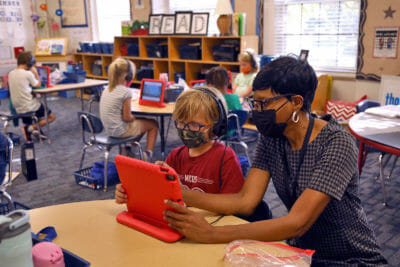 Yet another essential element to our work is challenging our growing readers, and this is accomplished in various ways. We may guide students to appropriate materials using the old-school five-finger rule, or new-school digital resources including online reading levels and testing data. In this growth process, we keenly observe to ensure our readers are doing so with a smile of enjoyment, rather than a frustrated frown. Aside from assisting students with books of their particular interest, we often communicate with homeroom teachers and learning specialists to determine levels of challenge appropriate to individual students. This year in Lower School, we have been blessed with the addition of a new Library Associate position, which focuses not only on library classes and duties but also individual reading support for students across the elementary grade levels. Mrs. Nicole Liebman has stepped into this role fluently, allowing the library to provide 1-1 support to our students, especially beginning or struggling readers. Over time, we hope to further establish this new position alongside the library and in cooperation with homeroom teachers to ensure appropriate challenges for all levels of readers in Lower School.
Yet another essential element to our work is challenging our growing readers, and this is accomplished in various ways. We may guide students to appropriate materials using the old-school five-finger rule, or new-school digital resources including online reading levels and testing data. In this growth process, we keenly observe to ensure our readers are doing so with a smile of enjoyment, rather than a frustrated frown. Aside from assisting students with books of their particular interest, we often communicate with homeroom teachers and learning specialists to determine levels of challenge appropriate to individual students. This year in Lower School, we have been blessed with the addition of a new Library Associate position, which focuses not only on library classes and duties but also individual reading support for students across the elementary grade levels. Mrs. Nicole Liebman has stepped into this role fluently, allowing the library to provide 1-1 support to our students, especially beginning or struggling readers. Over time, we hope to further establish this new position alongside the library and in cooperation with homeroom teachers to ensure appropriate challenges for all levels of readers in Lower School.
As is the case with our students and faculty, our wonderful library space is certainly not immune to COVID, and we respond as a school community. Teachers and students alike are still growing into new COVID-conscious Lower School. During read-alouds and lessons, students are assigned a specific seating order, ensuring the safety of contact tracing and social distancing. Bookshelves are now thoughtfully adorned with sanitizer bottles to keep little hands clean as can be!
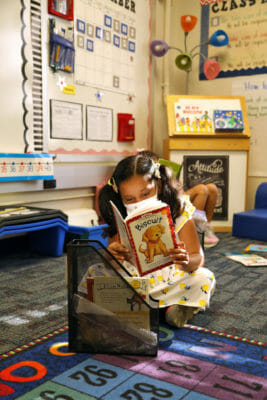 Alongside these protocol changes is the integration of more technology in the Library. Students often use their own personal devices to access digital resources such as the library catalog, eBook platforms, and our library homepage abundant with resources to use in any learning setting. We have been excited to partner with Mr. Greg Stevens to offer dual Library / Computer class time in upper grades, often collaborating to accomplish similar learning objectives and exit goals. Considering this rise in technology in the library setting, this partnership also carefully considers the idea of a healthy diet for students considering technology, screen time, and access to programs. Educational technology has seemingly gained momentum like wildfire in recent years (and even decades), and COVID has fanned these flames. We may look at this school year as a chance for a more controlled burn, so to speak, ensuring students at such young ages are provided with appropriate use of technology to enhance learning and nurture the whole child.
Alongside these protocol changes is the integration of more technology in the Library. Students often use their own personal devices to access digital resources such as the library catalog, eBook platforms, and our library homepage abundant with resources to use in any learning setting. We have been excited to partner with Mr. Greg Stevens to offer dual Library / Computer class time in upper grades, often collaborating to accomplish similar learning objectives and exit goals. Considering this rise in technology in the library setting, this partnership also carefully considers the idea of a healthy diet for students considering technology, screen time, and access to programs. Educational technology has seemingly gained momentum like wildfire in recent years (and even decades), and COVID has fanned these flames. We may look at this school year as a chance for a more controlled burn, so to speak, ensuring students at such young ages are provided with appropriate use of technology to enhance learning and nurture the whole child.
To summarize, we are blessed to see such abundant success within our student body across grade levels, and we are especially honored to carry on this work in the Lower School Library. Together we have come so far since those uncertain days in the spring of 2020, yet in a world with COVID our journey is, in many ways, still beginning as educators. My time working alongside colleagues at MICDS allows the confidence of knowing that our determination will continue to keep students on the path of academic, emotional, and social success for years to come—and at the heart of it all lies a good book, no doubt. As we continue on to new chapters, let us not forget the importance of developing readers for life!
